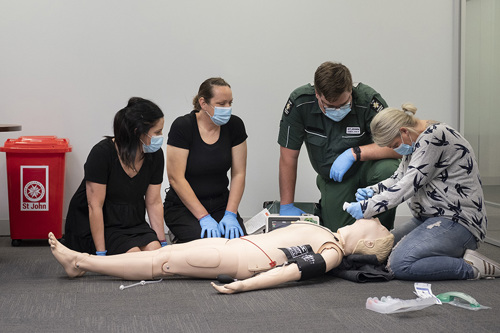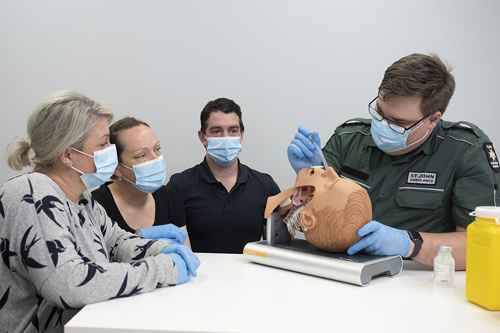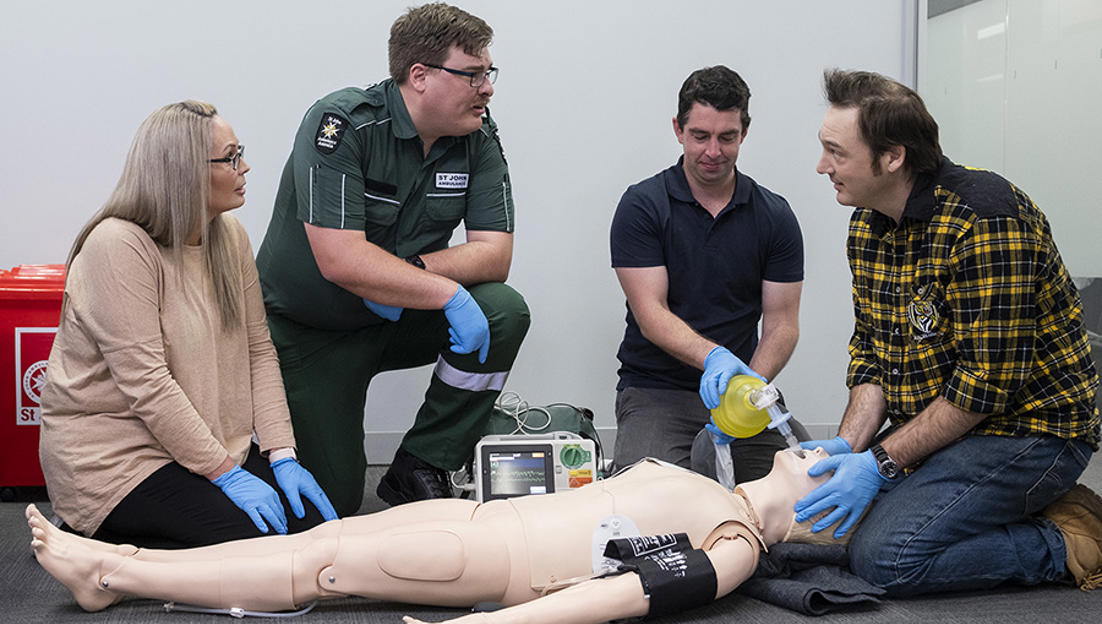HLT51020 Diploma of Emergency Health Care

Become an Ambulance Transport Attendant. This Diploma course is for those who have completed the Certificate III in Non-Emergency Patient Transport
Have you already completed the pre-requisite course in Certificate III in Non-Emergency Patient Transport?
Ready to enrol or have a question?
Enrol online to secure your place, or speak to us to find out more on 03 8588 8398 (Available Monday-Friday 9:00AM - 4:30PM AEST).
On-Demand Webinar
Watch our webinar and hear first-hand from our team. Learn all about Non-emergency Patient Transport courses and careers, and get an understanding what a day looks like in the role.

Hosted By:
Morgan (Ambulance Transport Attendant & Clinical Instructor), James (Ambulance Transport Attendant & Clinical Instructor) and Monica (Patient Transport Officer).
Patient transport is our business. With Trainers working in the industry, we know what it takes to train Ambulance Transport Attendants to the highest standard, producing high quality, job ready graduates.
THE QUALIFICATION
This qualification starts you on the pathway for a role as an Ambulance Transport Attendant, providing non-emergency transport and care for patients who have a low or medium acuity or chronic illness or disability and require transportation. You will gain the skills to provide clinical assessment and pre-hospital interventions to patients in need, including providing advanced skills in life support.
THE PROMISE
We are confident in the delivery of our training. On successful completion of the Diploma and application to careers@stjohnvic.com.au, graduates will be guaranteed an initial telephone interview for vacant positions in the Non-Emergency Patient Transport division at St John.
So far we have employed 100 graduates of our courses into our Non-Emergency Patient Transport division.
Watch how St John Patient Transport Officer, Harry, is furthering his career by training to become an Ambulance Transport Attendant
Upcoming course dates
- New class coming in September
This Diploma course is only for those who have completed the Certificate III in Non-Emergency Patient Transport
Free Placement with St John
Work placement is organised by St John. Please reach out if you don’t have workplace organised.
Career Pathways
Study HLT31120 Certificate III in Non-Emergency Patient Transport and become a qualified Patient Transport Officer.
This certificate is the entry qualification into the ambulance and patient transport industry.

Assessment Information
A successful outcome for this certificate will be determined by a range of different assessment methods including written assessment (questionnaire), observation of simulated and practical activities etc. You will be required to demonstrate CPR on a manikin on the floor.
Participants will also be required to undertake a wide range of manual handling tasks in preparation for future employment.
All the Assessment Task Workbooks will be provided by your trainer in Microsoft Word or PDF. You
will need to complete your answers in the workbook and email to your trainer. Your trainer will provide you feedback in your workbook. In the Assessment Task Workbook, each assessment task provides explicit instructions on how to complete the task.
Skills and Qualifications
Patient Transporter Skills and Qualifications
Customer Service, Customer Focus, Bedside Manner, Physical Fitness, Verbal Communication, Listening, Documentation Skills, Decision Making, Patient Services, Health Care Administration, Health Promotion and Maintenance
FAQs
Employment
On successful completion of the course, graduates will be guaranteed an initial telephone interview for vacant Ambulance Transport Attendant positions in the Non-Emergency Patient Transport division.
We have a strong preference to employ St John graduates as we are confident in the delivery of our training and find that our graduates are most job ready. So far, we have employed over 132 graduates of this course into our Non-Emergency Patient Transport division.
Positions can be casual, part-time or full-time. The availability of each type can depend on operational needs and your preference.
Shifts can be quite flexible. Some roles may offer a variety of shifts to suit different lifestyles, including day, night, and weekend shifts.
Rosters can vary, but typically involve a mix of different shift lengths and times throughout the week. The roster might include a combination of morning, afternoon, and night shifts, depending on hours and your availability.
Night shifts could be grouped together or spread across the week, depending on operational requirements and your preferences.
Casual roles do not require a fixed number of hours per week, allowing for more flexibility.
Yes, if you already have relevant qualifications, you may be able to apply directly for a role. Please visit our careers page for more information.
There are no age restrictions, some St John employees are even retired paramedics.
You will however have to have your full license to work in Patient Transport with St John.
The Role
The role involves transporting non-emergency patients, typically with medium or low acuity, to and from medical facilities. This includes ensuring the patient's safety, comfort, and well-being during the journey. The role may also require assisting patients with mobility issues, monitoring their condition, and communicating any relevant information to medical staff upon arrival.
A typical day could involve:
- Taking clients to medical appointments.
- Responding to 000 calls that are deemed non-time critical
- Responding to non-time critical events that escalate into time-critical events.
- Comforting patients and their family members.
Low Acuity
- Phil: A well-known walker dialysis patient that is transported 6 times per week. It seems like he is having an especially good day.
- Philis: Who is going to a new, unknown clinic today because her test results indicate a resurgence of cancer and she is wobbly on her feet and really unsure.
- David: Who narrowly escaped with his life after a sudden cardiac event and is flying back home via Air Ambulance with a new heart valve.
Medium Acuity
- Jaqueline: Who tripped on her pyjama pants and ended up on the ground.
- Mark: Who lives alone and takes blood thinners tripped over his beloved cat and his head has gone through some dry wall.
- Mary: Who came into the GP office with signs of stroke and St John were asked to assist with transport to hospital on a signal one.
Salary can vary based on the role, experience, shift days and times and whether the position is casual, part-time or full-time. Weekend penalties, night loadings and public holiday loadings available. There is also a tax deductible $18 meal allowance per shift.
St John Ambulance Victoria also provides salary packaging through Maxxia, allowing more of your pay to be tax free.
While the role requires understanding medical information, the training provided aims to equip you with the necessary skills and confidence. Continuous support and on-the-job learning help mitigate any feelings of being out of depth.
St John Ambulance Victoria offers opportunities for ongoing professional development and upskilling. This might include additional certifications, workshops, and on-the-job training.
The Course
The Diploma of Emergency Healthcare offers pathways for Recognition of Prior Learning (RPL) and Credit Transfer, allowing you to fast-track your qualification based on your previous experience and education.
Recognition of Prior Learning (RPL)
If you have prior work experience or have developed skills relevant to patient transport or healthcare, you may be eligible for RPL. This process assesses your existing knowledge and skills against the qualification requirements, reducing the time and study needed to complete the course.
Credit Transfer
If you have previously completed formal qualifications or units of competency that are relevant to this course, you may be eligible for credit transfer. This allows you to receive credit for units you've already completed, eliminating the need to repeat learning.
If you believe you may have some or all of the knowledge and skills covered in the units of competency, you may apply for Recognition of Prior Learning.
If you would like to apply for Recognition of Prior Learning, download and complete this form and forward to nept.training@stjohnvic.com.au
Yes, training includes how to manage and cope with unpredictable or aggressive patients, ensuring the safety and well-being of both the patient and the staff member.
Support is often available outside of workshop hours, including access to trainers, online resources, and peer support to help complete self-guided workbooks and modules.
You can complete the Diploma course on your Green P Plates. You will then need to wait until you have your full license before St John can hire you. Red P Plates and Learner Permits cannot begin the Diploma course.
The cost to complete the Diploma of Emergency Health Care starts from $8,995.00
8.30am - 4.30pm
It is the same day each week.
There is a maximum of 12 students in each class.
No, unless you don’t start working in the industry for a long time afterwards you shouldn’t need to redo it
Yes, it is a Nationally Recognised qualification
Additional Information
Students will be required to attend our training facility.
| Diploma Units |
|---|
| CHCLEG001 Work legally and ethically |
| HLTOUT005 Assess and deliver standard clinical care |
| HLTAID015 Provide advanced resuscitation and oxygen therapy** |
| HLTOUT008 Manage a scene |
| CHCCCS020 Respond effectively to behaviours of concern |
| Certificate Units |
|---|
| CHCDIV001 Work with diverse people + |
| HLTOUT010 Communicate in complex situations to support health care + |
| HLTWHS002 Follow safe work practices for direct client care + |
| HLTWHS006 Manage personal stressors in the work environment + |
| BSBMED301 Interpret and apply medical terminology appropriately + |
| HLTAAP002 Confirm physical health status + |
| HLTINF006 - Apply basic principles and practices of infection prevention and control + |
| HLTAAP001 Recognise healthy body systems + |
| HLTWHS005 Conduct manual tasks safely + |
| HLTOUT006 Transport emergency patients + |
| HLTOUT007 Transport non-emergency patients under operational conditions + |
| HLTOUT001 Implement safe access and egress + |
* In order to undertake HLTAID015 Provide advanced resuscitation and oxygen therapy participants are required to undertake HLTAID011 Provide first aid unit as a pre-requisite. HLTAID011 is completed as part of the Certificate III in Non-Emergency Patient Transport which is a separate course with its own fees and charges.
+These units are completed as part of the HLT31120 Certificate III in Non-Emergency Patient Transport
EARN MONEY WHILE YOU COMPLETE YOUR DIPLOMA
Upon successful completion of the first 12 units (plus the prerequisite HLTAID011), you will be qualified to start working as a Patient Transport Officer
Contact us to find out more about course fees.
- Diploma for Students who hold HLT31120/HLT41120 - 5 units* consisting of 18 workshops of face to face training and 160 hours of placement
- *Dependent on prior qualification, Students may require GAP training
- Students are also required to complete self-paced workbooks, and self-guided learning.
- During weeks with classes, these run 8.30am-5pm one day per week, you are also expected to complete self-guided learning. During weeks where there are no classes and your on-road observation shifts are conducted, you are also expected to complete self-guided learning activities.
- Students are given 12 months from course commencement date to complete the course.
To commence in this course, you are required to have:
- Full Driver’s Licence or Green P Plates (Red P and L plates not accepted).
- Current working with children check
- Current Police check
- Students must have a laptop or tablet which is wi-fi enabled
- Proof of vaccinations for current Influenza (within the last 12 months), COVID 19, Hepatitis B, Varicella, Pertussis, Measles/Mumps/Rubella, with serology report (required before commencing observer shifts)
- Students must be clean shaven for infection control (PPE requirements) on observer shifts
If you believe you may have some or all of the knowledge and skills covered in the units of competency, you may apply for Recognition of Prior Learning.
If you would like to apply for Recognition of Prior Learning, download and complete this form and forward to diploma.training@stjohnvic.com.au
A successful outcome for this diploma will be determined by a range of different assessment methods including written assessment, observation of simulated and practical activities etc. You will be required to demonstrate CPR on a manikin on the floor.
Participants will also be required to undertake a wide range of manual handling tasks in preparation for future employment.
All the Assessment Task Workbooks will be provided by your trainer in Microsoft Word or PDF. You will need to complete your answers in the workbook and email to your trainer. Your trainer will provide you feedback in your workbook. In the Assessment Task Workbook, each assessment task provides explicit instructions on how to complete the task.
As an Ambulance Transport Attendant, you can expect your day to day work to include:
- Transporting patients to and from medical appointments
- Responding to emergency calls that have been deemed non-time critical
- Taking a leadership role within the team to ensure high standards of patient care and safety
- Comforting patients and their families by offering support and encouragement; being punctual and attentive to procedure schedules; demonstrating caring and cultural sensitivity
- Maintaining safe, secure, and healthy work environment by following standards and procedures; complying with federal and state legal regulations and Joint Commission on Accreditation of Healthcare Organizations (JCAHO) requirements
- Updating your job knowledge by participating in educational opportunities
- Enhancing the reputation of the organisation by accepting ownership for accomplishing new and different requests; exploring opportunities to add value to job accomplishments
Graduates of the HLT51020 – Diploma of Emergency Health Care can use this qualification to secure employment in the private sector, or in some cases work overseas. This diploma is also a proven pathway to university to study a paramedicine degree, which is the new standard to become a registered Ambulance Paramedic.



